Multi-Periodicity of High-Frequency Type III Bursts as a Signature of the Fragmented Magnetic Reconnection
Abstract
:1. Introduction
2. Data
2.1. Data Description
2.2. Method of Radio Data Analysis
3. Results
4. Discussion and Conclusions
Author Contributions
Funding
Informed Consent Statement
Data Availability Statement
Acknowledgments
Conflicts of Interest
References
- Priest, E.R.; Forbes, T.G. The magnetic nature of solar flares. Astron. Astrophys. Rev. 2002, 10, 313–377. [Google Scholar] [CrossRef]
- Aschwanden, M.J. Particle acceleration and kinematics in solar flares—A Synthesis of Recent Observations and Theoretical Concepts (Invited Review). Space Sci. Rev. 2002, 101, 1–227. [Google Scholar] [CrossRef]
- Krucker, S.; Battaglia, M.; Cargill, P.J.; Fletcher, L.; Hudson, H.S.; MacKinnon, A.L.; Masuda, S.; Sui, L.; Tomczak, M.; Veronig, A.L.; et al. Hard X-ray emission from the solar corona. Astron. Astrophys. Rev. 2008, 16, 155–208. [Google Scholar] [CrossRef]
- Schrijver, C.J. Driving major solar flares and eruptions: A review. Adv. Space Res. 2009, 43, 739–755. [Google Scholar] [CrossRef]
- Fletcher, L.; Dennis, B.R.; Hudson, H.S.; Krucker, S.; Phillips, K.; Veronig, A.; Battaglia, M.; Bone, L.; Caspi, A.; Chen, Q.; et al. An Observational Overview of Solar Flares. Space Sci. Rev. 2011, 159, 19–106. [Google Scholar] [CrossRef]
- Nakariakov, V.M.; Pilipenko, V.; Heilig, B.; Jelínek, P.; Karlický, M.; Klimushkin, D.Y.; Kolotkov, D.Y.; Lee, D.H.; Nisticò, G.; Van Doorsselaere, T.; et al. Magnetohydrodynamic Oscillations in the Solar Corona and Earth’s Magnetosphere: Towards Consolidated Understanding. Space Sci. Rev. 2016, 200, 75–203. [Google Scholar] [CrossRef]
- Carmichael, H. A Process for Flares. NASA Spec. Publ. 1964, 50, 451. [Google Scholar]
- Sturrock, P.A. Model of the High-Energy Phase of Solar Flares. Nature 1966, 211, 695–697. [Google Scholar] [CrossRef]
- Hirayama, T. Theoretical Model of Flares and Prominences. I: Evaporating Flare Model. Sol. Phys. 1974, 34, 323–338. [Google Scholar] [CrossRef]
- Kopp, R.A.; Pneuman, G.W. Magnetic reconnection in the corona and the loop prominence phenomenon. Sol. Phys. 1976, 50, 85–98. [Google Scholar] [CrossRef]
- Aulanier, G.; Janvier, M.; Schmieder, B. The standard flare model in three dimensions. I. Strong-to-weak shear transition in post-flare loops. Astron. Astrophys. 2012, 543, A110. [Google Scholar] [CrossRef] [Green Version]
- Janvier, M.; Aulanier, G.; Bommier, V.; Schmieder, B.; Démoulin, P.; Pariat, E. Electric Currents in Flare Ribbons: Observations and Three-dimensional Standard Model. Astrophys. J. 2014, 788, 60. [Google Scholar] [CrossRef]
- Dudík, J.; Janvier, M.; Aulanier, G.; Del Zanna, G.; Karlický, M.; Mason, H.E.; Schmieder, B. Slipping Magnetic Reconnection during an X-class Solar Flare Observed by SDO/AIA. Astrophys. J. 2014, 784, 144. [Google Scholar] [CrossRef]
- Karlický, M.; Rybák, J. The 2017 September 6 Flare: Radio Bursts and Pulsations in the 22–5000 MHz Range and Associated Phenomena. Astrophys. J. Suppl. Ser. 2020, 250, 31. [Google Scholar] [CrossRef]
- Aschwanden, M.J. Physics of the Solar Corona. An Introduction; Springer: Berlin/Heidelberg, Germany, 2004. [Google Scholar]
- Jiřička, K.; Karlický, M. Narrowband Pulsating Decimeter Structure Observed by the New Ondřejov Solar Radio Spectrograph. Sol. Phys. 2008, 253, 95–101. [Google Scholar] [CrossRef]
- Meegan, C.; Lichti, G.; Bhat, P.N.; Bissaldi, E.; Briggs, M.S.; Connaughton, V.; Diehl, R.; Fishman, G.; Greiner, J.; Hoover, A.S.; et al. The Fermi Gamma-ray Burst Monitor. Astrophys. J. 2009, 702, 791–804. [Google Scholar] [CrossRef]
- Lemen, J.R.; Title, A.M.; Akin, D.J.; Boerner, P.F.; Chou, C.; Drake, J.F.; Duncan, D.W.; Edwards, C.G.; Friedlaender, F.M.; Heyman, G.F.; et al. The Atmospheric Imaging Assembly (AIA) on the Solar Dynamics Observatory (SDO). Sol. Phys. 2012, 275, 17–40. [Google Scholar] [CrossRef]
- Karlický, M.; Rybák, J. Oscillation Maps in the Broadband Radio Spectrum of the 1 August 2010 Event. Sol. Phys. 2017, 292, 1. [Google Scholar] [CrossRef]
- Karlický, M.; Rybák, J.; Monstein, C. Oscillations in the 45–5000 MHz Radio Spectrum of the 18 April 2014 Flare. Solar Phys. 2017, 292, 94. [Google Scholar] [CrossRef]
- Torrence, C.; Compo, G.P. A Practical Guide to Wavelet Analysis. Bull. Am. Meteorol. Soc. 1998, 79, 61–78. [Google Scholar] [CrossRef]
- Farge, M. Wavelet transforms and their applications to turbulence. Annu. Rev. Fluid Mech. 1992, 24, 395–457. [Google Scholar] [CrossRef]
- Karlický, M.; Chen, B.; Gary, D.E.; Kašparová, J.; Rybák, J. Drifting Pulsation Structure at the Very Beginning of the 2017 September 10 Limb Flare. Astrophys. J. 2020, 889, 72. [Google Scholar] [CrossRef]
- Loureiro, N.F.; Schekochihin, A.A.; Cowley, S.C. Instability of current sheets and formation of plasmoid chains. Phys. Plasmas 2007, 14, 100703. [Google Scholar] [CrossRef]
- Uzdensky, D.A.; Loureiro, N.F.; Schekochihin, A.A. Fast Magnetic Reconnection in the Plasmoid-Dominated Regime. Phys. Rev. Lett. 2010, 105, 235002. [Google Scholar] [CrossRef]
- Shibata, K.; Tanuma, S. Plasmoid-induced-reconnection and fractal reconnection. Earth Planets Space 2001, 53, 473–482. [Google Scholar] [CrossRef]
- Karlický, M.; Bárta, M. Successive Merging of Plasmoids and Fragmentation in a Flare Current Sheet and Their X-Ray and Radio Signatures. Astrophys. J. 2011, 733, 107. [Google Scholar] [CrossRef]
- Tajima, T.; Sakai, J.; Nakajima, H.; Kosugi, T.; Brunel, F.; Kundu, M.R. Current Loop Coalescence Model of Solar Flares. Astrophys. J. 1987, 321, 1031. [Google Scholar] [CrossRef]
- Sakai, J.I.; de Jager, C. Solar Flares and Collisions Between Current-Carrying Loops Types and Mechanisms of Solar Flares and Coronal Loop Heating. Space Sci. Rev. 1996, 77, 1–192. [Google Scholar] [CrossRef]
- Park, H.K.; Choi, M.J.; Kim, M.; Kim, M.; Lee, J.; Lee, D.; Lee, W.; Yun, G. Advances in physics of the magneto-hydro-dynamic and turbulence-based instabilities in toroidal plasmas via 2-D/3-D visualization. Rev. Mod. Plasma Phys. 2022, 6, 18. [Google Scholar] [CrossRef]
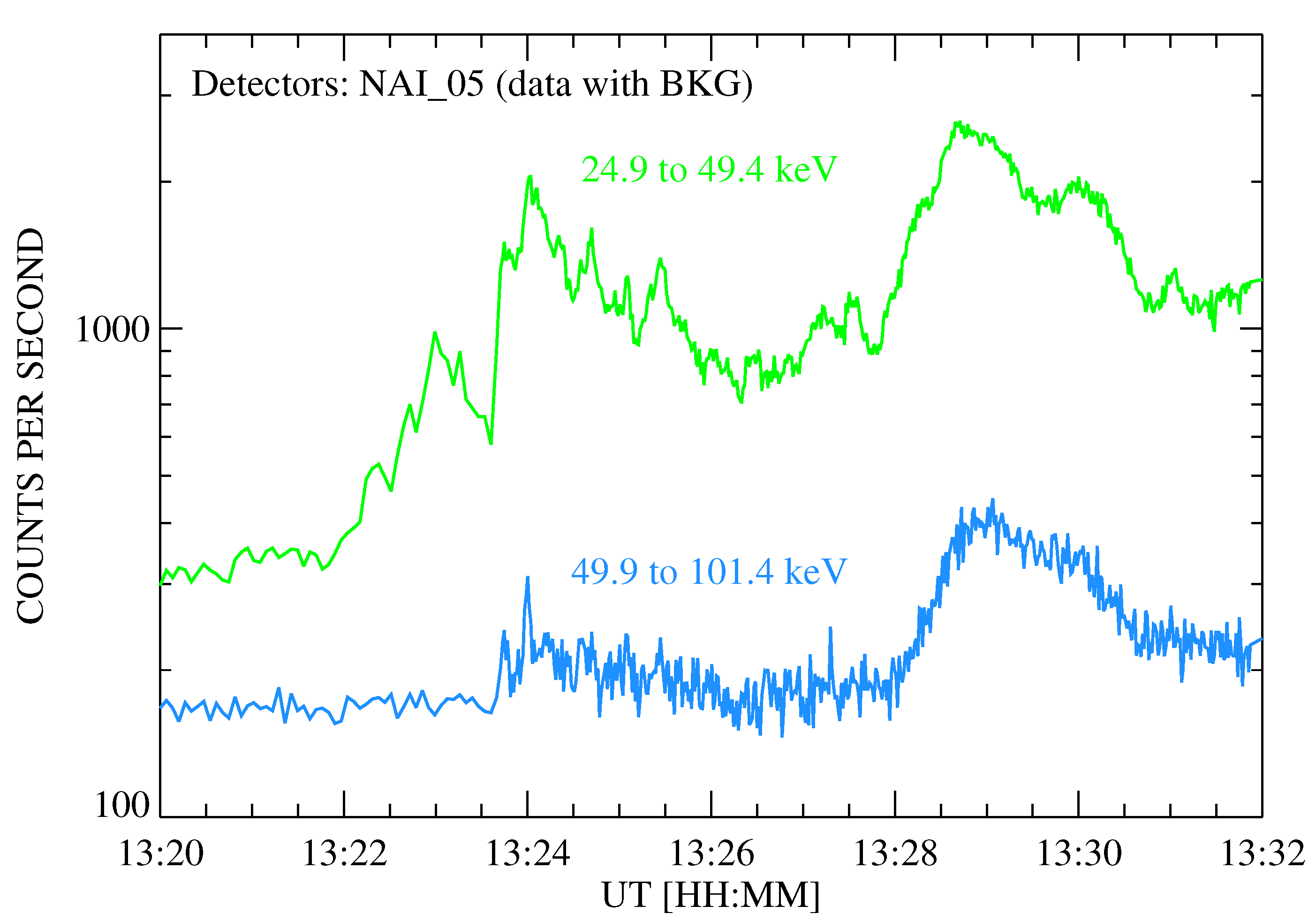
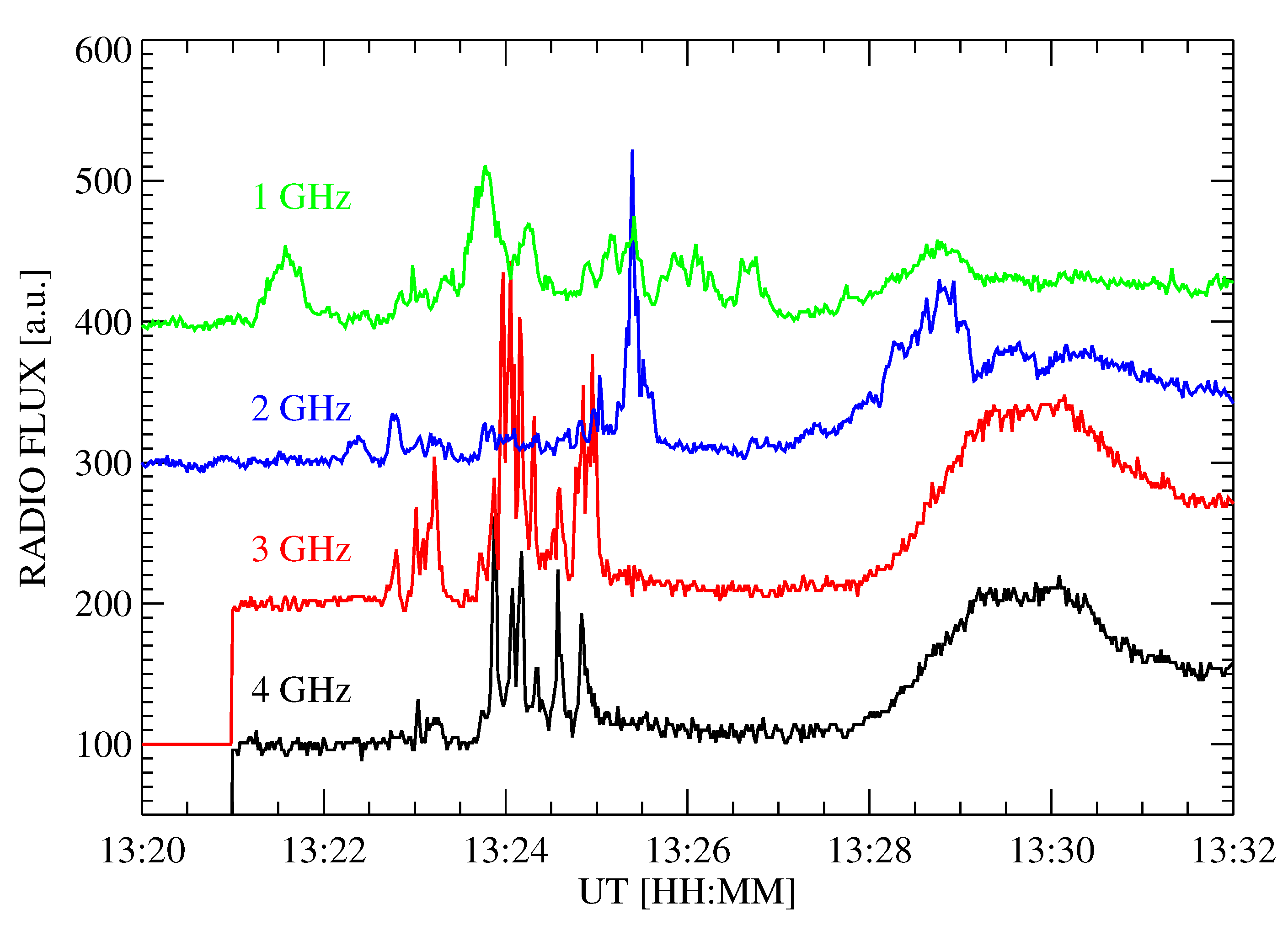

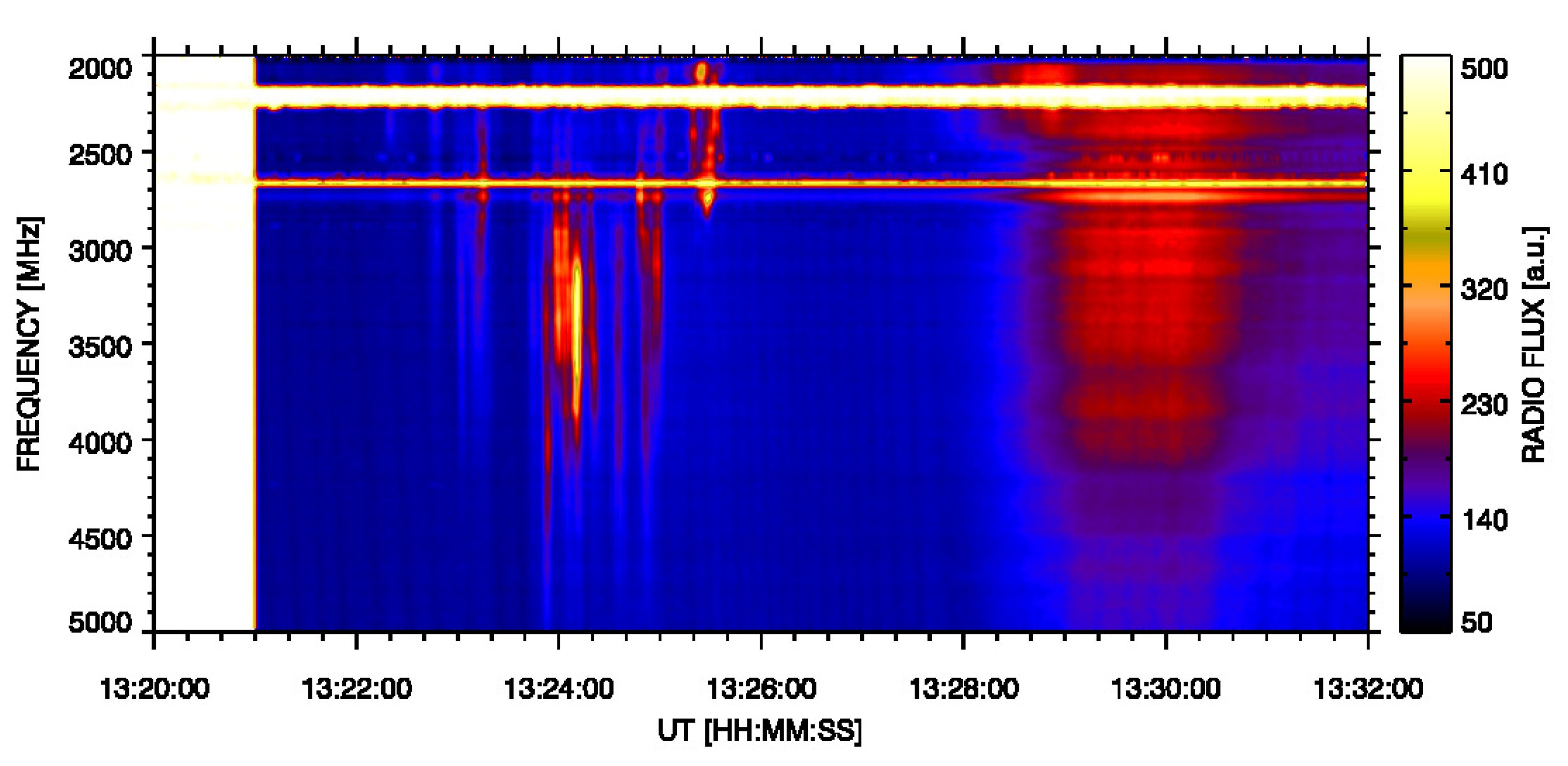
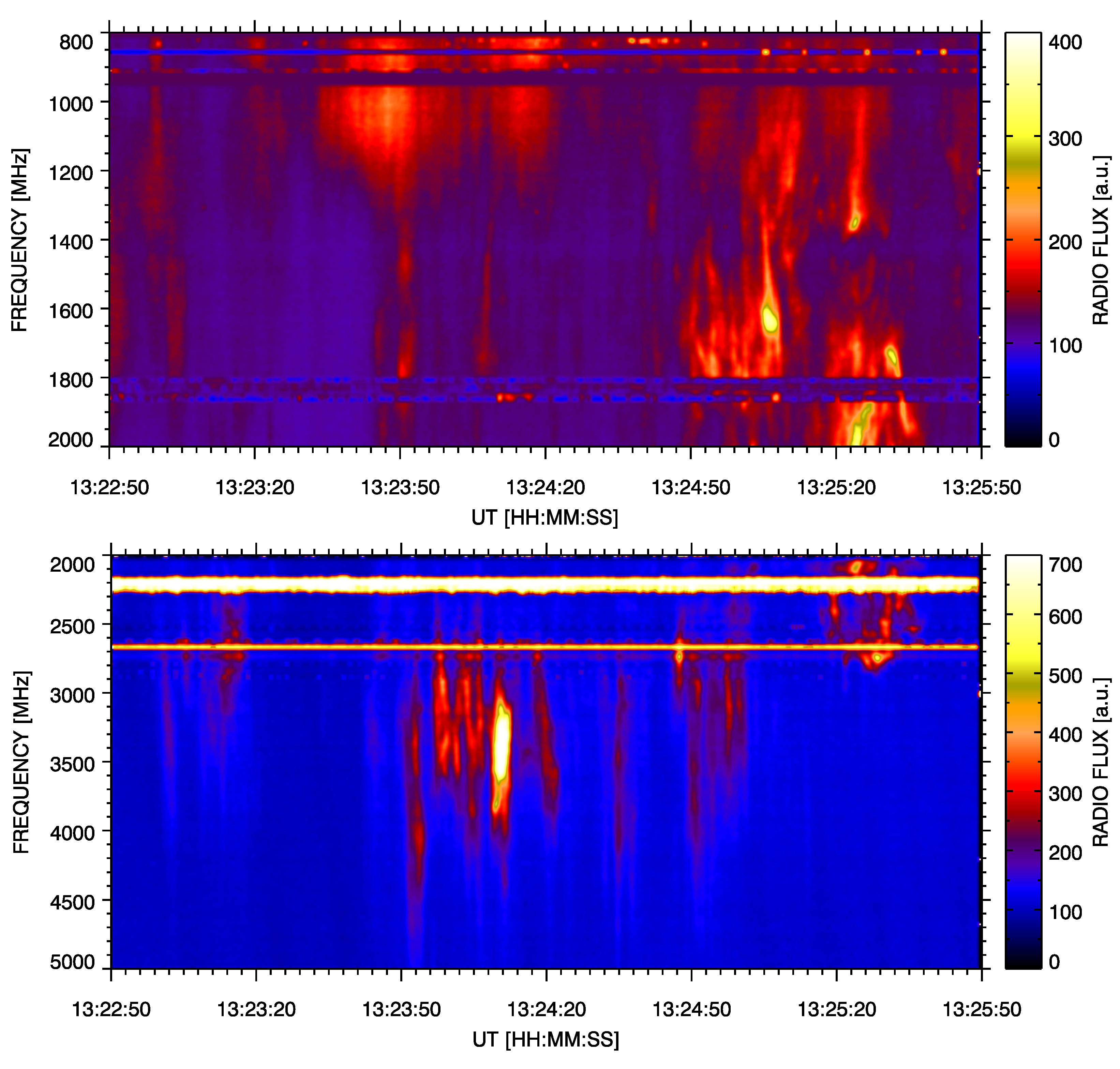
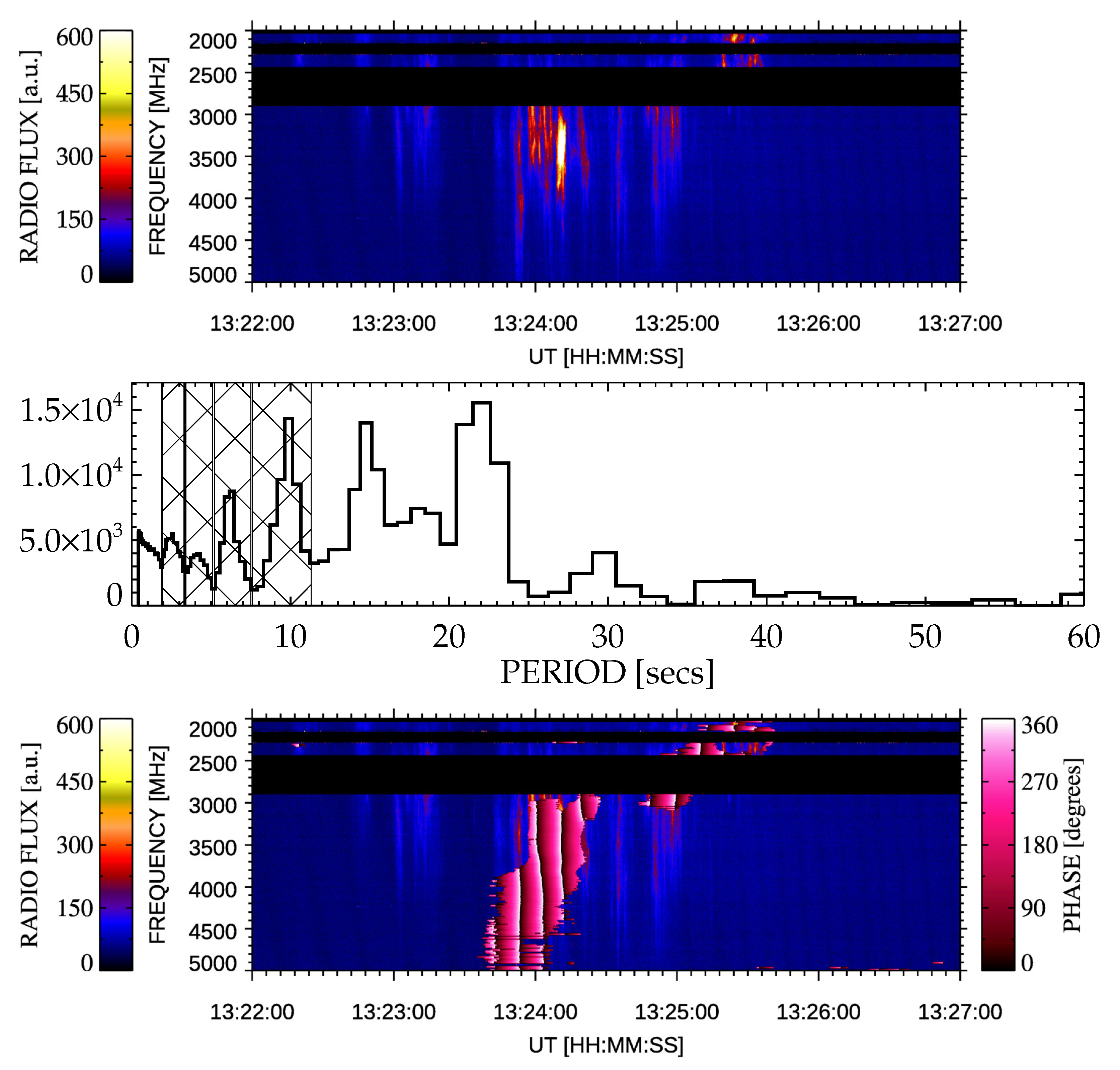

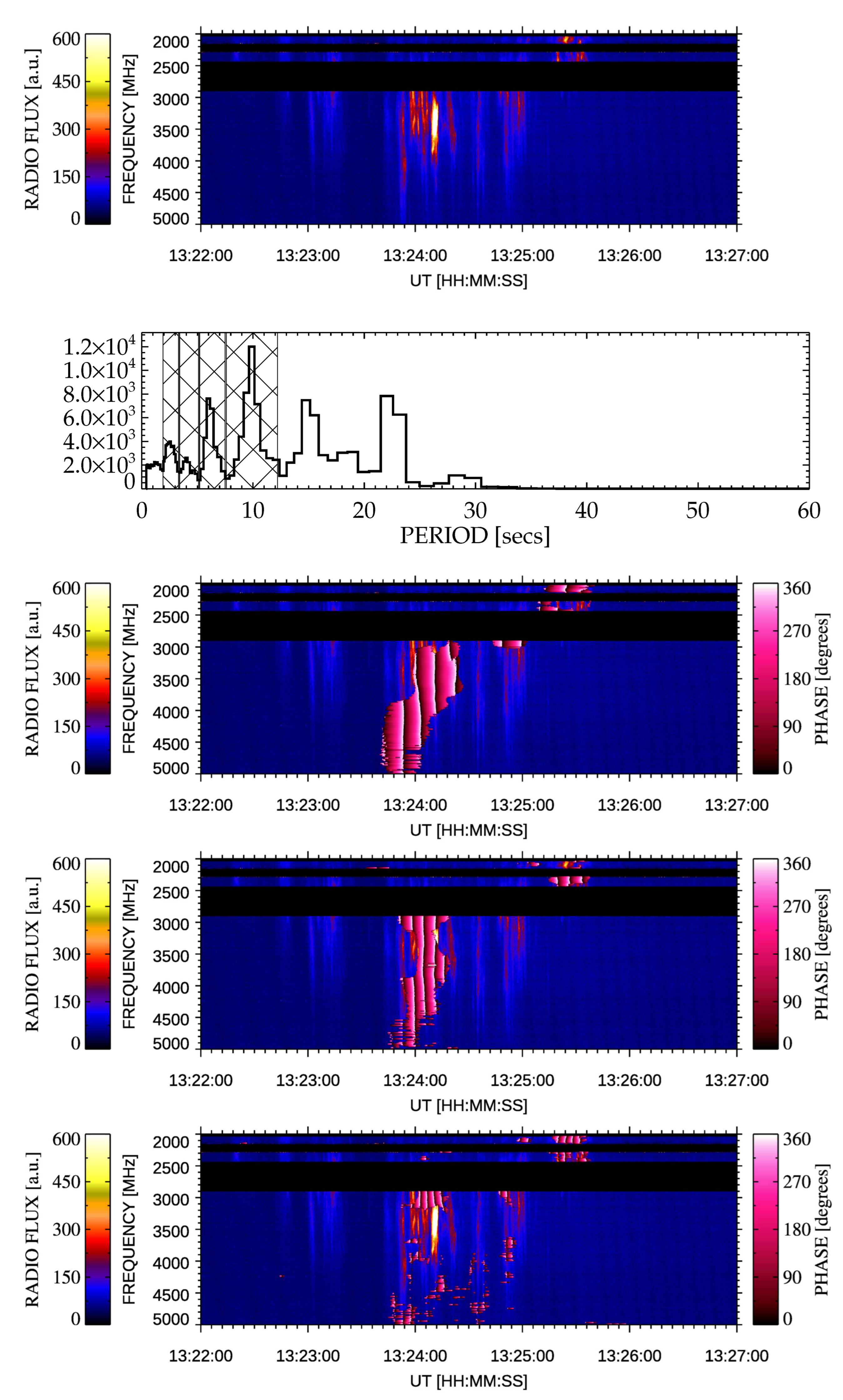

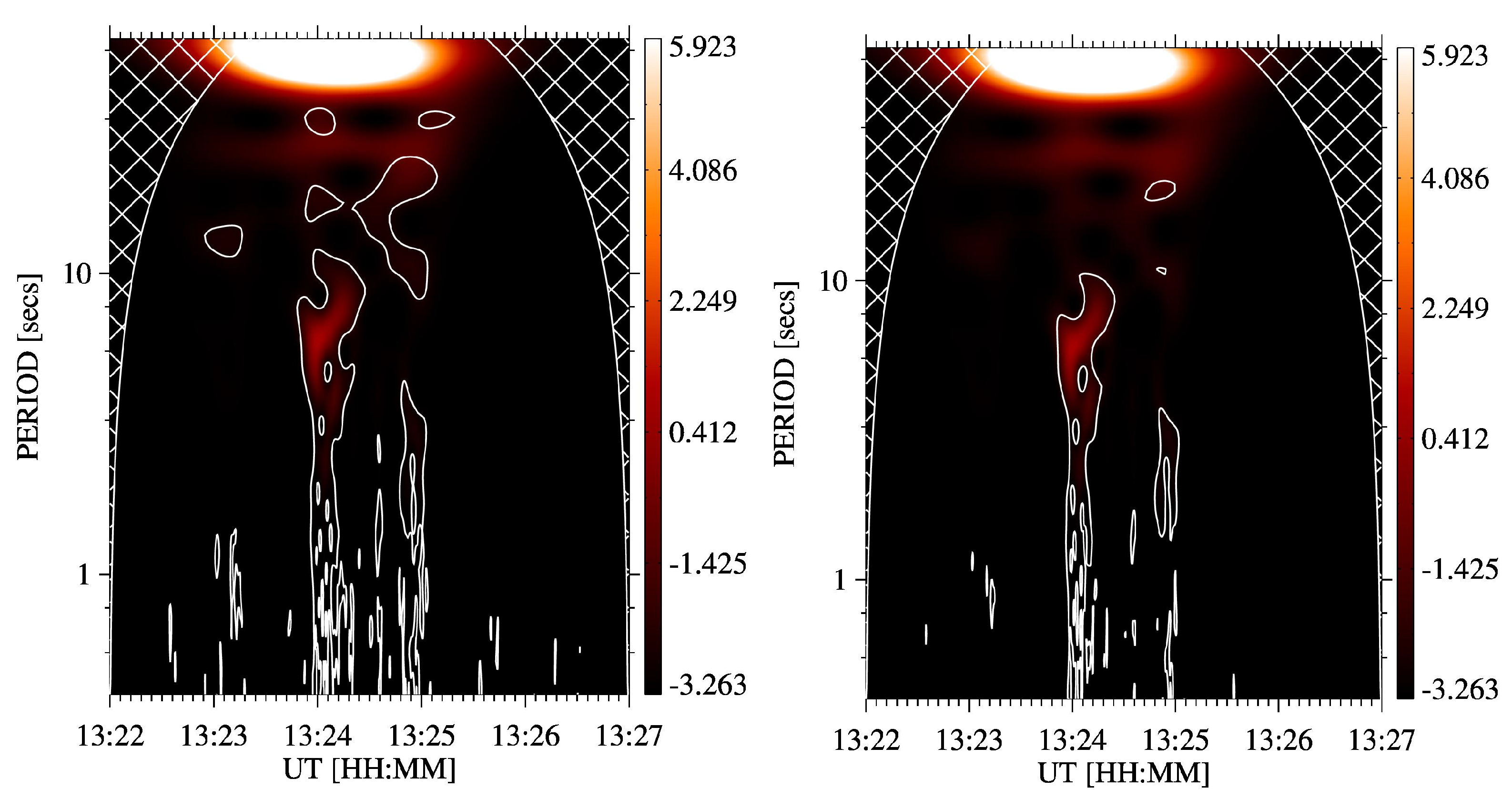

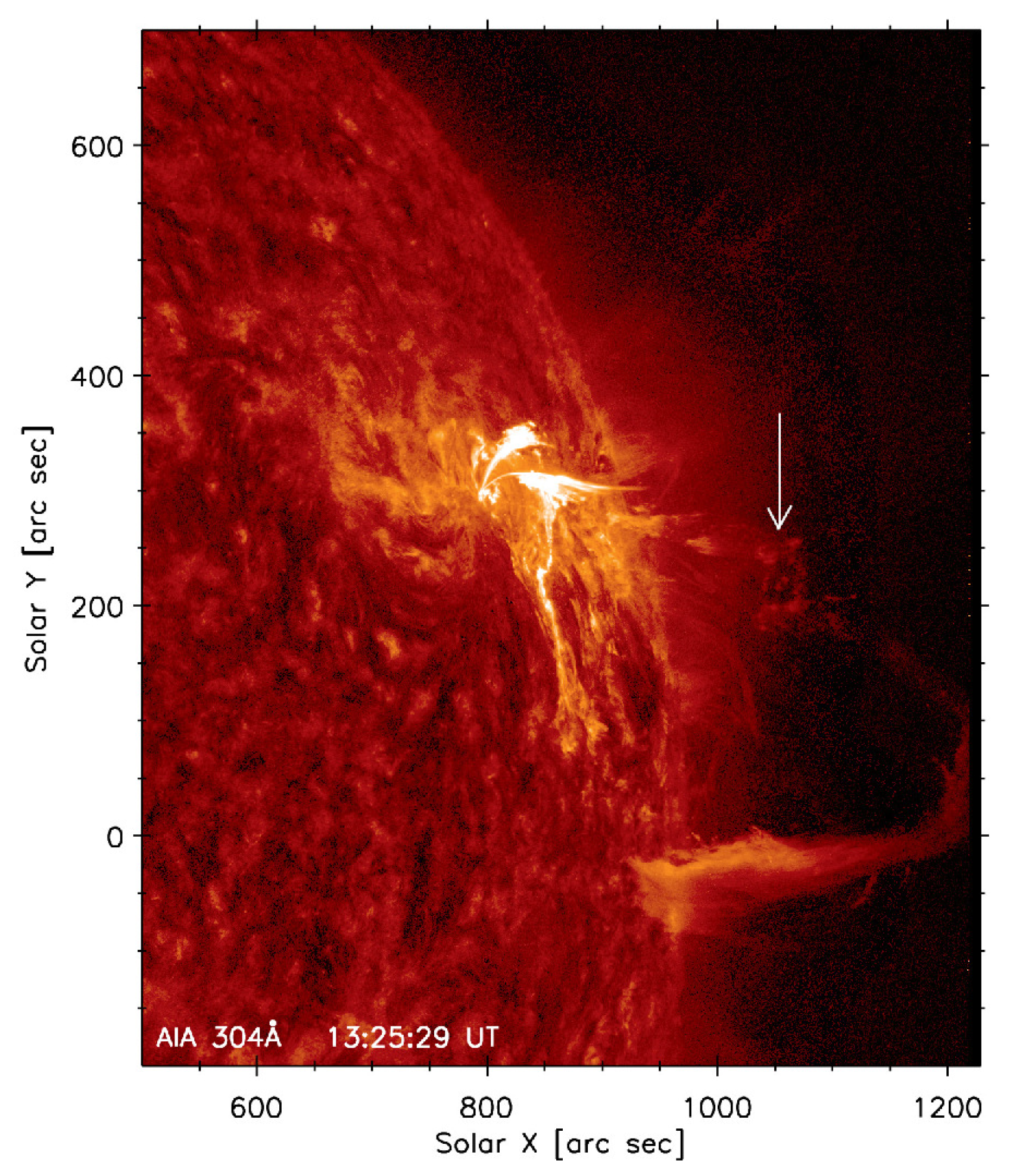
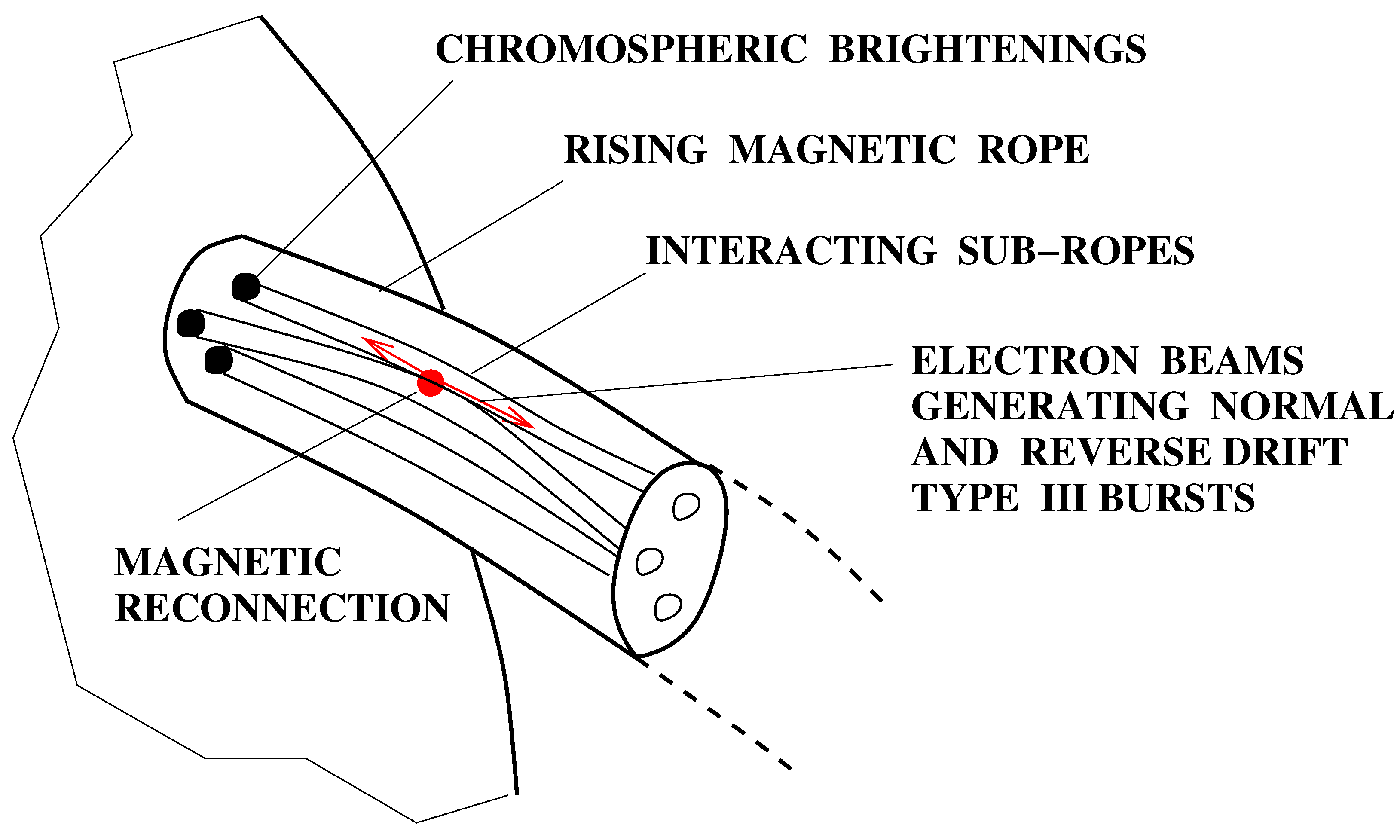
Disclaimer/Publisher’s Note: The statements, opinions and data contained in all publications are solely those of the individual author(s) and contributor(s) and not of MDPI and/or the editor(s). MDPI and/or the editor(s) disclaim responsibility for any injury to people or property resulting from any ideas, methods, instructions or products referred to in the content. |
© 2023 by the authors. Licensee MDPI, Basel, Switzerland. This article is an open access article distributed under the terms and conditions of the Creative Commons Attribution (CC BY) license (https://creativecommons.org/licenses/by/4.0/).
Share and Cite
Karlický, M.; Rybák, J. Multi-Periodicity of High-Frequency Type III Bursts as a Signature of the Fragmented Magnetic Reconnection. Universe 2023, 9, 92. https://doi.org/10.3390/universe9020092
Karlický M, Rybák J. Multi-Periodicity of High-Frequency Type III Bursts as a Signature of the Fragmented Magnetic Reconnection. Universe. 2023; 9(2):92. https://doi.org/10.3390/universe9020092
Chicago/Turabian StyleKarlický, Marian, and Ján Rybák. 2023. "Multi-Periodicity of High-Frequency Type III Bursts as a Signature of the Fragmented Magnetic Reconnection" Universe 9, no. 2: 92. https://doi.org/10.3390/universe9020092




